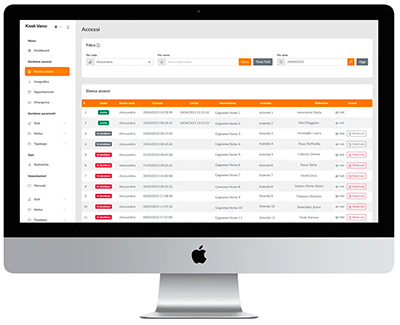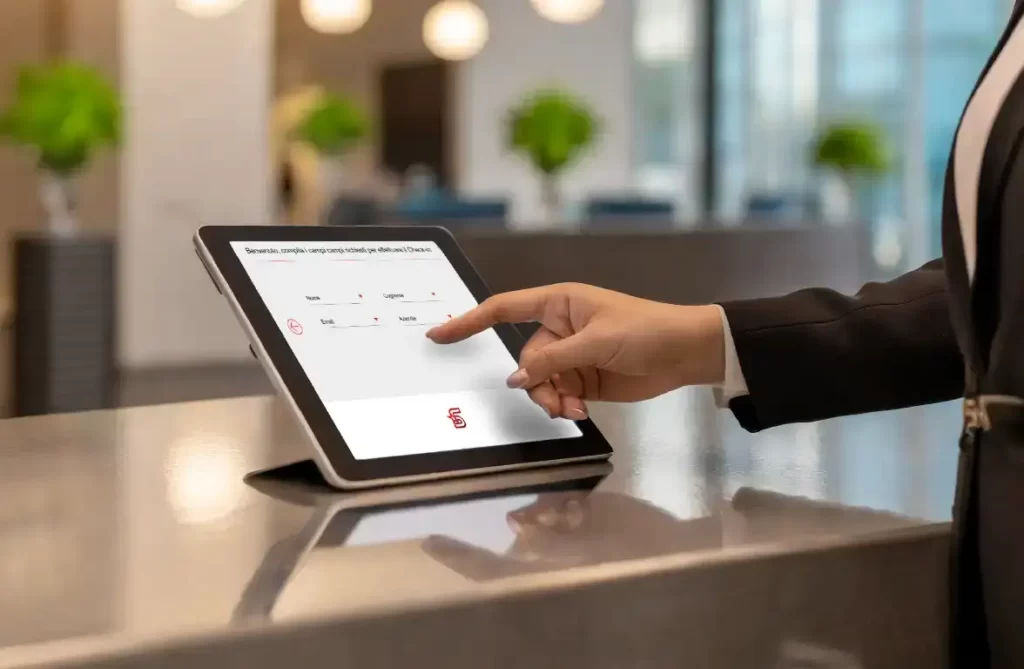Visitor registration is a crucial aspect for any business. Over the years, the visitor registration process has moved from a paper-based procedure to a modern digital system. An evolution that has brought about a number of advantages, including greater efficiency and security, as well as stricter respect for visitor privacy.
In this article, we’ll explore the differences between the two approaches and the importance of ensuring the privacy of visitors’ personal information.
The paper procedure: gaps and risks for privacy
In the past, the company relied on a paper form to register visitors. This method was subject to numerous loopholes and risks, especially regarding the privacy of visitor information. In fact, visitor data was easily accessible to anyone and was often stored in an insecure manner, without adequate destruction or conservation protocols.
Additionally, visitors’ personal information was vulnerable to theft, unauthorized access, or loss. The company did not have complete control over the information and could not guarantee its confidentiality.
Not only did this jeopardize visitor privacy, but it could also damage the company’s reputation for security and reliability.
The digital age: the transformation towards a secure and privacy-friendly system
With the advent of digital technology, many companies have abandoned the paper procedure and adopted visitor registration systems based on specific software and applications. This transition has brought numerous benefits for both the company and the visitors.
First, digital visitor registration allows you to create centralized profiles that can be managed securely and protected from unauthorized access.
Visitors’ personal information is encrypted and can only be accessed by those with the proper permissions. This helps ensure greater privacy and protect sensitive information in accordance with GDPR regulations.
In addition, digital recording allows for more efficient data management. Information can be easily retrieved and analyzed, allowing the company to have a more accurate overview of visits and improve resource planning.
Respect for privacy with digital recording systems
For digital systems to offer greater security and privacy than paper-based methods, it is imperative that businesses strictly comply with visitor data privacy regulations.
This involves taking appropriate cybersecurity measures, such as using data encryption, implementing access controls, and having clear visitor data handling policies in place.
Furthermore, it is essential that companies inform visitors about how they collect, store and use personal data.
Clear information should be provided on the purpose of the registration, the duration of data retention and the rights of visitors regarding their privacy. Transparency is key to building trust and respect for visitor privacy.
Registration of visitors to the company
The introduction of visitor registration software on tablets has brought about a number of significant benefits.
Systems such as the Kiosk Varco have transformed the way companies manage visitor reception, offering benefits in terms of privacy, management, security, costs, immediate access and service.
In this article, we will explore the benefits of these software in detail, analyzing the different aspects in which they translate.
- Improved privacy: The use of visitor logging software allows for better respect for visitor privacy. Personal information can be entered directly into the digital system, thus avoiding the risk of loss or unauthorized access to paper data. The data can be managed securely, with security and encryption protocols that guarantee the confidentiality of personal information.
 Efficient management : Visitor registration software on tablets simplifies information management. Visitor data is collected in a structured way and can be easily organised, searched and archived. This allows you to have a complete overview of visits, simplifies report generation and facilitates the tracking of visitor information over time.
Efficient management : Visitor registration software on tablets simplifies information management. Visitor data is collected in a structured way and can be easily organised, searched and archived. This allows you to have a complete overview of visits, simplifies report generation and facilitates the tracking of visitor information over time.- Improved security: Tablet-based visitor registration software offers greater security than older paper-based methods. Access controls, such as requiring authentication, can be implemented to ensure that only authorized personnel can access visitor information. Additionally, these software can integrate with corporate security systems, allowing for more accurate monitoring of visitor access and identifying potential security threats or risks.
- Cost reduction: The introduction of visitor registration software on tablets can lead to cost reductions in the long run. By eliminating the need to print and maintain paper record cards, businesses can save on paper, printer and storage costs. Furthermore, the management and analysis of digital data can be automated, reducing the use of human resources dedicated to repetitive tasks.
- Immediate access to information: With visitor registration software on tablets, visitor information is instantly available and easily accessible. Reception staff can quickly view details of registered visitors, including emergency contacts, special instructions or personal preferences. This allows for a more personalized and efficient reception experience and a quick review of visitors present in the building.
- Service improvement: Visitor registration software on tablets offer faster and more efficient service. Visitors can register independently, even remotely, saving time for them and for the reception staff. In addition, being able to instantly view visitor details allows you to offer a more personalized service, anticipating their needs and providing a welcoming and professional experience.
- Behavioral analysis of visitors: the registration systems allow to archive and therefore to trace the entries of visitors, thus outlining their behavioral habits.
What a good access logging system should look like.
A successful digital recording system for business receptions should offer a number of key functions and ensure ease of use for both visitors and reception staff.
Now let’s see some important aspects that such a system should have:
- Intuitive Interface: The system should feature an intuitive and user-friendly user interface. It must be easy to navigate and require a minimum number of steps for visitor registration. Buttons and options should be clear and easy to understand, making the signup process quick and efficient.
- Complete registration form: The system must allow the collection of all necessary information from visitors, such as first and last name, telephone number, reason for the visit and contact person in the company. Also, it can be helpful to include additional fields for special requirements or specific instructions for reception staff.
- Personalization: A valid registration system should allow for the personalization of the requested information. Every business may have different needs, so it’s important that the system allows you to add or edit registration fields based on your specific business needs.
- Printing of personalized badges: The system should be able to immediately print a personalized badge for the registered visitor. The badge should contain relevant information, such as the visitor’s name, photo, and login instructions. This makes it easier for visitors to identify within the company and provides a professional look.
- Arrival Notifications: The system could send automatic notifications via email or SMS to the employee waiting for the registered visitor. In this way, staff can be promptly informed of the visitor’s arrival and welcome them without delays or confusion.
- Data storage and access: The system should allow visitor data to be recorded in a secure and encrypted manner. Furthermore, it should be possible to store data in a centralized database and allow easy access and search of information relating to previous visitors.
- Reporting functions: The system should be able to generate reports and statistics on visitor visits, providing an overview of the activities and allowing for better planning of company resources.
- Technical Support and Updates: A good system should provide robust technical support and regular updates to ensure that the software is secure and aligned with evolving business needs.
In summary, a valid digital recording system for company receptions should be intuitive, complete in functionality and customizable. It must streamline the visitor registration process, improve security, and provide efficient information management.
How much does a visitor registration system cost
The cost of a digital visitor registration system can vary based on several factors, including the specifications of the system, the number of devices required, the complexity of the implementation, and the vendor selected.
It is important to note that the following information is indicative and can vary considerably:
- Software and licenses: The cost of visitor recording software can vary depending on the features offered and the licenses required.
- Hardware: The cost of the hardware depends on the type of device used for visitor registration, such as tablets or interactive kiosks. The price of the devices may vary depending on the brand, technical specifications and screen size. You also need to consider the cost of additional accessories such as mounts, built-in cameras or badge printers. The prices of the devices can range from a few hundred to several thousand euros per unit.
- Customization and Integrations: If you require customization or integration with other enterprise systems, such as visitor management system or access control, additional development or custom configuration fees may be required. These costs depend on the complexity of the requests and can vary widely.
- Implementation and training: It is also important to consider the costs associated with implementing the system and training personnel. While some vendors may provide guided implementation and initial setup support, you may need to dedicate internal or external resources for installation, configuration, and staff training. These costs can vary depending on the size and complexity of the business and the complexity of the solution.
- Supporto e manutenzione: I costi associati al supporto tecnico continuo e alla manutenzione del sistema possono essere inclusi nel costo del software o richiedere un abbonamento separato. Be sure to carefully evaluate these charges to ensure adequate support and software updates over time.
Conclusions
Visitor registration in the company has gone from an ancient paper procedure to a modern digital system. This evolution has brought many benefits, including greater efficiency and greater data security. However, it is essential that companies strictly respect the privacy of visitors in digital systems, adopting adequate security measures and informing visitors about the processing of their personal data.
Only in this way can the company guarantee a professional welcome that respects privacy for all visitors.






